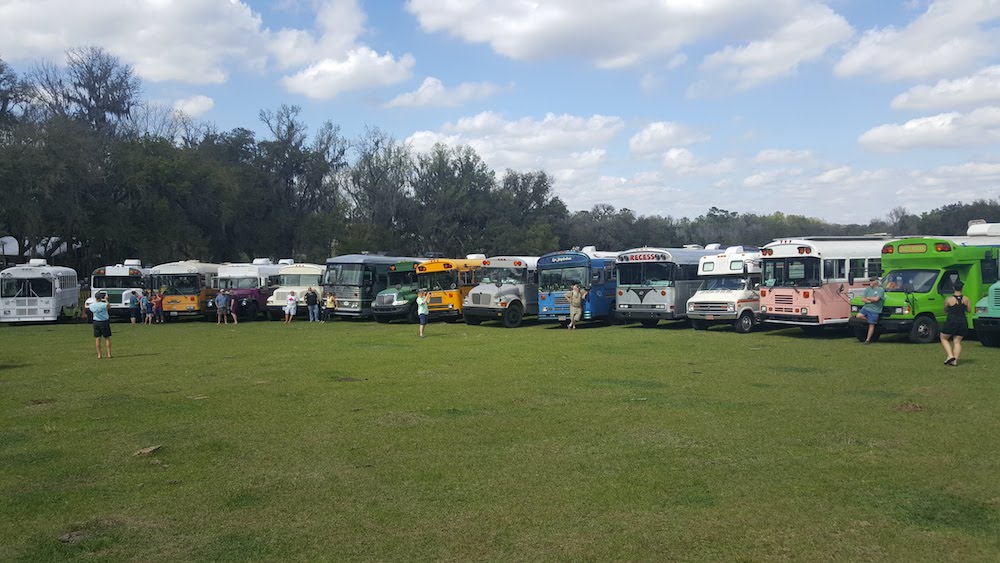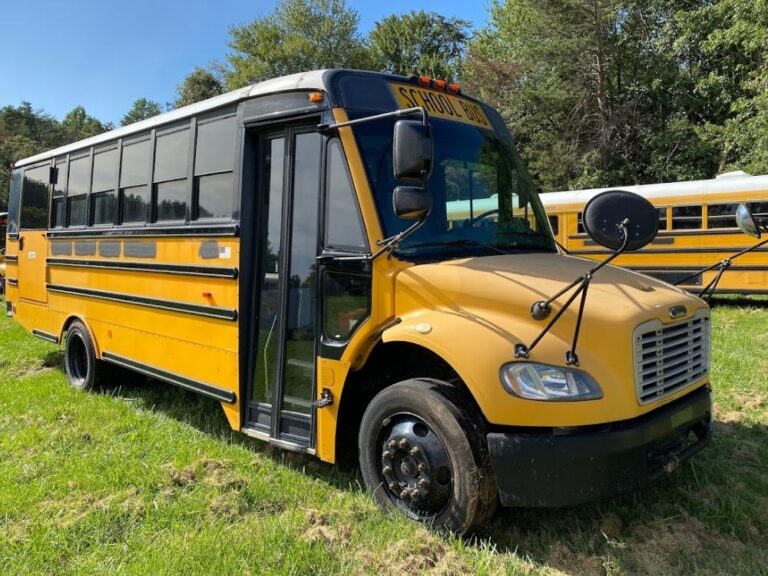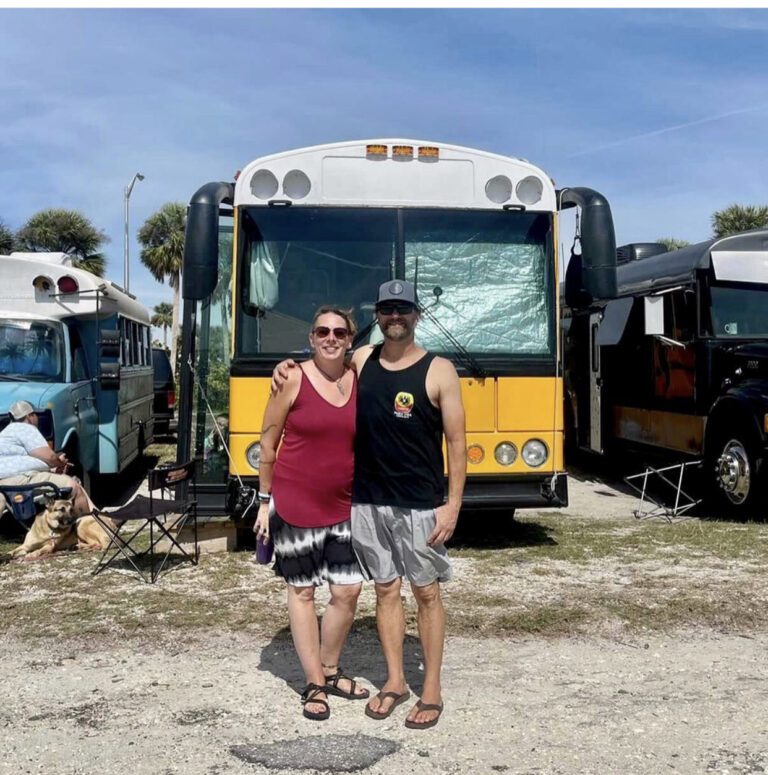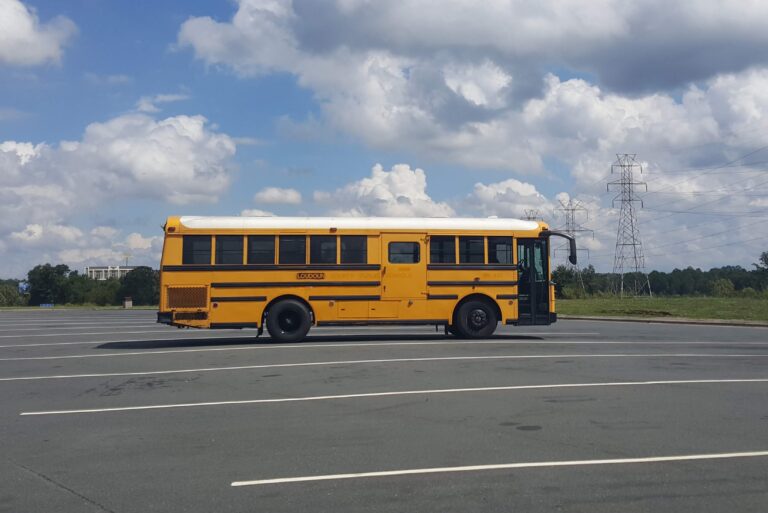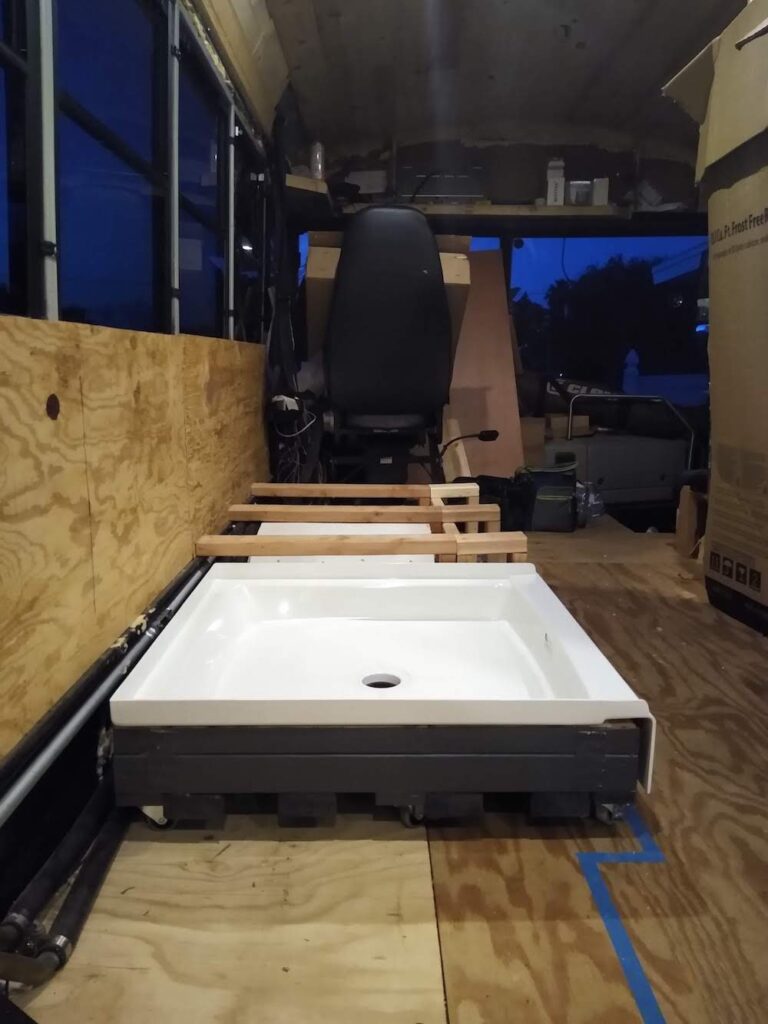School Bus Sizes For A Skoolie Conversion
Deciding on what school bus-size you chose for your build is one of the first decisions you will make. There are so many variables that go into contemplating the perfect size bus.
We are going to address some of the most common questions regarding school bus sizes here and how those questions and answers affect you and your skoolie life.

What Are The Different Sizes of School Buses?
The type and size bus you have been dreaming about is out there. You just have to find it. There are many different sizes of buses available to meet the floor plan needs of just about anyone.
Check out this post we wrote on The Best Skoolie Floor Plans
When we first talked about building a tiny house on wheels, Don wanted an MCI type of bus to convert and Nat wanted to convert a van.
So, we compromised and stumbled across the skoolie. We were instantly hooked. We then had to decide on a shorty, a mid-size, or a full-size bus.
The great, but sometimes frustrating thing with those three choices, is that there is a multitude of choices within each category.
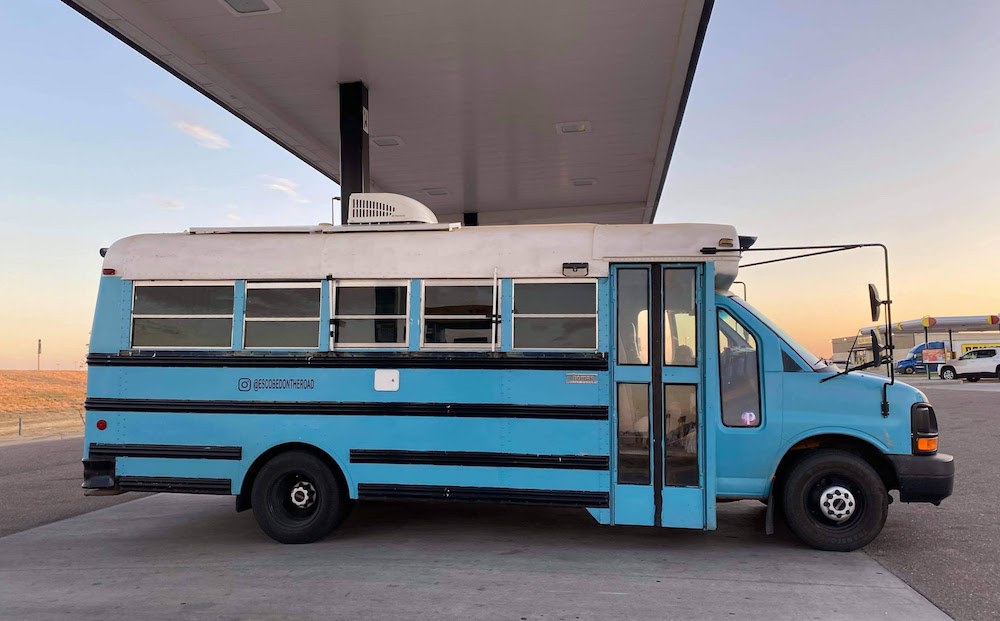
Choosing the size of the bus you want to build can be one of the biggest decisions you can make. If you would like more information on this process, read this article on Choosing The RIght Skoolie.
How Big Is A Full-Size School Bus?
First of all, let us preface this answer by saying, a “full-size” bus is a very subjective term. Full-size could mean and apply to several types of buses.
Perhaps the more appropriate question would be, “How big is the largest school bus available?”
Now, we do have an answer to that question. Also, we will circle back to the original question of “how big is a full-sized bus?” as well.
Longest or Biggest Full-Size Bus
First, let’s talk about the longest or biggest school bus available.
The longest available school bus for a skoolie conversion is a Type D school bus. These buses are transit style and designed for long trips typically involving band or sports teams activities.
The type D school bus has a maximum length of 45 feet. Not all type D buses are 45 feet long, but that is the maximum length.
The type D bus is still 90 inches in interior diameter. You can get a type D bus with a front, mid or rear engine and all of them are flat-nose.
Now, back to the original question of “how big is a full-sized bus?”
Traditional Full-Size School Bus
Most “full-size class C or class D buses are 40’ in length and 90” of interior width. This equates to approximately 262 square feet of living or building space on the interior. These buses are right at about 10.4 feet from the ground to the crest of the roof.
So, as you can see, a “full-size” bus is large indeed. Whether you choose to go with a 40 foot or a 45-foot bus, you should have plenty of room for yourself and your family. Tiny house on wheels doesn’t always have to be “tiny”.
How Wide Is A Type C School Bus?
We talked a little bit about a “full-size” bus and a Type D bus. What about the Type C school bus?
A Type C school bus is a traditional-looking school bus. In the skoolie community, we call them a “Dog-nose” skoolie, because of the “snout” front end.
The engine cover on Type C gives it that “dog-nose” look and feel.
Our second skoolie build is a Type C school bus. We are building out a Thomas C2 for our current build. We wanted a more traditional-looking skoolie and one that drives more like a van or truck than a bus.
The width difference between a Type D, Type A, and Type C bus is negligible. They have a minimum width of 93 overall inches and an interior width of 90 inches. That is 7 ½ feet of interior width which makes for a comfortable width to build on.

What Are The Dimensions Of A 72 Passenger School Bus?
A 72 passenger bus comes in a Type D chassis as well as a Type C chassis. It is probably the most common sized school bus across the United States school districts.
You are likely to see a Type C 72 passenger bus each morning on your way to work between the hours of 6:30 and 8:30.
The typical 72 passenger bus is right about 34 feet long, 7 ½ feet wide, and 10.4 feet in height.
Pro-Tip
Be sure to measure the height of your skoolie from the ground to the crest of the highest point on your roof.
Write that height down and place it visibly when you are driving. Always know if the height clearance of a bridge or overhead structure is high enough for your skoolie.
How Are School Bus Sizes Measured?
How school bus sizes are measured maybe a little bit deceiving on what most people really want to know when they are building a skoolie.
The exterior dimensions of a bus, front bumper to rear bumper, is how buses are measured in length, width, and height in feet or inches.
The height of a bus is measured from the ground to the crest of the ceiling or the crest of any rooftop attachments such as air conditioners, fans, or lights. All modern school buses have a white blinking strobe light that must be operational while picking up or dropping off children.
This strobe light is not mandatory to remove when using a school bus for private use, unlike the red and amber upper lights that must be removed for private use.
The typical school bus is measured at 34 feet long, 7 ½ inches wide, and 10.4 feet tall.
The Window Rule For Bus Length Estimation
A great hack for determining the exterior as well as the interior length or the approximate length of a bus is to count the windows and multiply by 2.5.
Each standard school bus window is 2.7 inches from the middle of the frame to the next middle of the frame. The glass window itself is 2.5 feet wide.
By counting the number of windows and then doing the multiplication, you can get a rough but close to the accurate length of a bus.
This also comes in quite handy when trying to imagine and do a mental layout of the interior or floorplan of your skoolie.
If you are trying to estimate the total square footage of a bus, then simply follow the formula:
# of windows x 2.5 x 7.5 = total square footage
You still have to account for the drivers’ cockpit when determining total length. On a dog nose bus, you must account for the cockpit area as well as the engine cover.
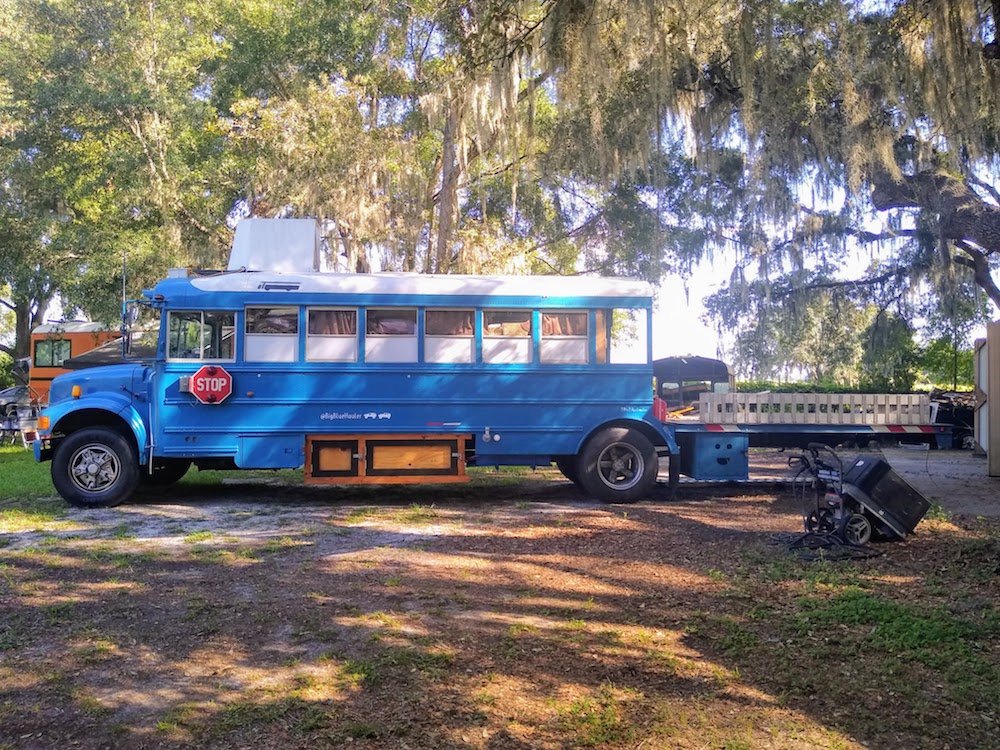
Choosing A School Bus-size For Your Conversion
We have discussed different types of school buses and their dimensions. When choosing a school bus-size for your conversion, there are some things to consider before choosing the bus.
How much room do you actually need v. how much room do you want?
The reason this is an important consideration is the more room you have, the more stuff you are going to find to fill up that space with the stuff.
When we started living and traveling in our first bus, we had just about everything we owned in that sucker.
After about 6 months on the bus, we realized we were hauling around stuff we didn’t even know was in our bus.
Do yourself a favor and only build what you need and use. If you have family heirlooms and childhood memories you want to preserve, put them in storage or convince a family member to store them for you in their home.
What Size Skoolie Do I Need?
How many people are going to be living in your skoolie? How many pets and what size are those pets that are going to be living and traveling in your skoolie?
Where are you wanting to travel, boondock or camp?
What is your fuel budget and how comfortable are you driving a large bus?
These are the questions you should be seriously considered when deciding on what size skoolie you need.
Use the window method for determining the square footage and take a conservative view if you honestly feel it will be enough for you.
Bigger is not always better and smaller is not always simpler. Having the proper size skoolie to fit your skoolie lifestyle and budget is what is most important.
Other Factors To Consider When Sizing Your Skoolie
Engine Location
Engine location may or may not be a big deal for you. When it comes to school bus sizes, the location of the engine doesn’t really carry much weight unless you are trying to decide on a flat-nose or dog-nose skoolie.
The dog-nose skoolie is going to add approximately 10 feet to the overall length of your bus when comparing total square footage.
Total Square Footage
How much room do you really need? Are you wanting a minimalist tiny house on wheels so you can explore and travel at your whim? Maybe you are wanting a boujie, luxurious tiny house on wheels that can accommodate friends and family occasionally.
Square footage makes a high difference when living in something full-time. We went from around 220 square feet in our first bus to about 80 square feet in our Sprinter.
The Sprinter was a dream to drive and travel in, especially at 22mpg, but it was an absolute nightmare for us to live in.
Now, we have settled in on a 30-foot dognose that will give us approximately 150 square feet of living space which sounds just perfect for us.
Conversion Location
Where are you going to complete the demolition and more importantly, where are you going to complete the build?
This could have some legal implications if your residence or where you think you are going to complete the build does not allow a large bus.
You may get away with a Type A school bus in a neighborhood because they are relatively small and on a van chassis.
The conversion location is a serious consideration when determining the type and size of the bus you would like to convert.
Many of our friends have chosen to do both the demolition as well as the build itself at The Skoolie Homestead Community in Jesup, Georgia. Not only is it an ideal place to complete your conversion, but there is also lots of help and advice to be had from other DIY builders as well.
On top of being a great Homestead Community, Bret, the owner with his wife Renee, is a conversion expert and is available for hire to assist you on the complete or partial builds.
Overall Costs
Overall Costs pertain to not just the cost of materials to convert your bus. It also pertains to overall maintenance and repairs for your skoolie.
The bigger your skoolie is, the more materials it will cost to convert it to your tiny home on wheels. Especially considering the costs of lumber, plywood, copper wiring at this point in our economy, it could get expensive quickly!
If you plan on traveling full time, you must consider fuel prices and general maintenance. The cost of diesel is pretty high right now with a national average of $3.73 per gallon. That is up almost $.20 from just a month ago.
Consider tires at an average cost of $400/tire and your skoolie is likely to have 6 of them. On that note, roadside assistance insurance is on top of insurance for your skoolie itself and all of your personal belonging.
Just be realistic and prepared for the cost to own, operate and build your skoolie, regardless of what size you choose.
Wrap Up – School Bus Sizes
School bus sizes are like anything else in our lives that require a rational and emotional decision. We must weigh the pros and cons versus the wants and the needs.
Although this may cause a temporary and slight quandary when deciding on the right size skoolie for you, school bus sizes are one of the greatest appeals of a DIY camper.
You get to decide what size your RV is going to be. No two skoolies are the same. We love the uniqueness and individuality that go into each build. From roof raises and exterior paint jobs and schemes to interior design and floorplan layouts.
All of the different sizes and types of school buses there are to choose from is a credit to the idea of the skoolie movement.
Tell us what type of bus you have or plan to purchase and why.
We would love to feature you on our Skoolie Community Page. Follow this link and complete the brief questionnaire.
We look forward to connecting with you!

